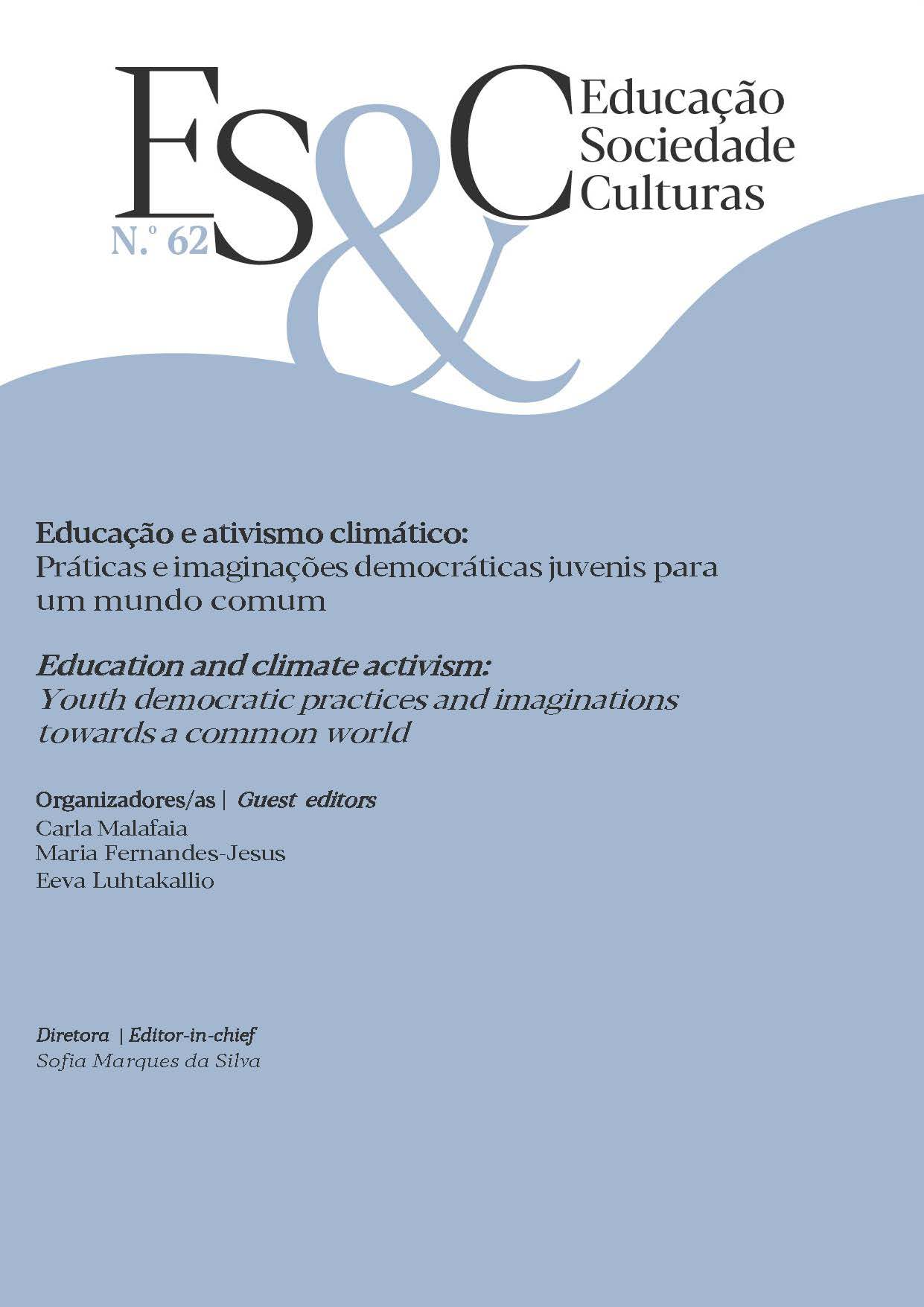Imagine isto
Investigando os impactos das mudanças climáticas na saúde mental dos jovens utilizando a metodologia photovoice como intervenção
DOI:
https://doi.org/10.24840/esc.vi62.264Palavras-chave:
eco-ansiedade, eco-luto, photovoice, jovem, mudanças climáticasResumo
Este artigo foca nos impactos das mudanças climáticas na saúde mental de jovens e adultos/as, especificamente os/as estudantes universitários/as de programas relacionados com o meio ambiente. A metodologia photovoice foi utilizada como ferramenta de recolha de dados e analisada como potencial intervenção para gerir os impactos na saúde mental relacionado com o clima e empoderar os/as jovens. Os/As jovens envolvidos/as experimentaram diversos impactos na saúde mental relacionados com as mudanças climáticas, derivados de experiências, incluindo a própria educação ambiental. Para lidar com isso, os/as participantes recorreram a fontes primárias de resiliência, incluindo passar tempo na natureza, participar de atividades na comunidade, promover ações ambientais e praticar reflexão consciente. O estudo a partir da metodologia photovoice reflete elementos-chave dessas estratégias de coping e os/as jovens experimentaram melhorias subjetivas na saúde mental e bem-estar, desenvolvendo empoderamento. Concluímos, recomendando a gestão dos impactos na saúde mental relacionados com as mudanças climáticas, melhorando o apoio à saúde mental em instituições pós-secundárias.
Recebido: 25/1/2022
Aceite: 25/5/2022
Downloads
Referências
Baker, Cambry, Clayton, Susan, & Bragg, Eshana (2021). Educating for resilience: Parent and teacher perceptions of children’s emotional needs in response to climate change. Environmental Education Research, 27(5), 687-705. https://doi.org/10.1080/13504622.2020.1828288
Bulla, Brian, & Steelman, Toddi (2016). Farming through change: Using photovoice to explore climate change on small family farms. Agroecology and Sustainable Food Systems, 40(10), 1106-1132. https://doi.org/10.1080/21683565.2016.1225623
Clayton, Susan (2018). Mental health risk and resilience among climate scientists. Nature Climate Change, 8(4), 260261. https://doi.org/10.1038/s41558-018-0123-z
Clayton, Susan, & Karazsia, Bryan (2020). Development and validation of a measure of climate change anxiety. Journal of Environmental Psychology, 69, 101434. https://doi.org/10.1016/j.jenvp.2020.101434
Clayton, Susan, Manning, Christie, Krygsman, Kirra, & Speiser, Meighen (2017). Mental health and our changing climate: Impacts, implications, and guidance. American Psychological Association; ecoAmerica. https://www.apa.org/news/press/releases/2017/03/mental-health-climate.pdf
Cook, Kristin (2014). Beginning a classroom inquiry: Using photovoice to connect college students to community science. Journal of College Science Teaching, 43(6), 28-33. http://www.jstor.org/stable/43631756
Craps, Stef (2020). Introduction: Ecological grief. American Imago, 77(1), 1-7. https://doi.org/10.1353/aim.2020.0000
Cunsolo, Ashlee, Harper, Sherilee, Minor, Kelton, Hayes, Katie, Williams, Kimberly, & Howard, Courtney (2020). Ecological grief and anxiety: The start of a healthy response to climate change? The Lancet Planetary Health, 4(7), e261–e263. https://doi.org/10.1016/S2542-5196(20)30144-3
Derr, Victoria, & Simons, Jordin (2020). A review of photovoice applications in environment, sustainability, and conservation contexts: Is the method maintaining its emancipatory intents? Environmental Education Research, 26(3), 359-380. https://doi.org/10.1080/13504622.2019.1693511
Franco, Lara, Shanahan, Danielle, & Fuller, Richard (2017). A review of the benefits of nature experiences: More than meets the eye. International Journal of Environmental Research and Public Health, 14(8), 864. https://doi.org/10.3390/ijerph14080864
Han, Christina, & Oliffe, John (2015). Photovoice in mental illness research: A review and recommendations. Health: An Interdisciplinary Journal for the Social Study of Health, Illness and Medicine, 20(2), 110-126. https://doi.org/10.1177/1363459314567790
Hatala, Andrew, Njeze, Chinyere, Morton, Darrien, Pearl, Tamara, & Bird-Naytowhow, Kelley (2020). Land and nature as sources of health and resilience among Indigenous youth in an urban Canadian context: A photovoice exploration. BMC Public Health, 20(1), 538-538. https://doi.org/10.1186/s12889-020-08647-z
Helm, Sabrina, Pollitt, Amanda, Barnett, Melissa, Curran, Melissa, & Craig, Zelieann (2018). Differentiating environmental concern in the context of psychological adaption to climate change. Global Environmental Change, 48, 158-167. https://doi.org/10.1016/j.gloenvcha.2017.11.012
Hickman, Caroline, Marks, Elizabeth, Pihkala, Panu, Clayton, Susan, Lewandowski, Eric, Mayall, Elouise, Wray, Britt, Mellor, Catriona, & van Susteren, Lise (2021). Climate anxiety in children and young people and their beliefs about government responses to climate change: A global survey. The Lancet Planetary Health, 5(12). https://doi.org/10.1016/s2542-5196(21)00278-3
Kelly, Anna (2017). Eco-anxiety at university: Student experiences and academic perspectives on cultivating healthy emotional responses to the climate crisis. Independent study project (ISP) collection. 2642. https://digitalcollections.sit.edu/isp_collection/2642
Kleres, Jochen, & Wettergren, Åsa (2017). Fear, hope, anger, and guilt in climate activism. Social Movement Studies, 16(5), 507-519. https://doi.org/10.1080/14742837.2017.1344546
Kluttz, Jenalee (2020). Climate change and mental health: A systemic approach to action in post-secondary education (UBC Sustainability Scholars report). University of British Columbia. https://sustain.ubc.ca/sites/default/files/2020-11_Climate%20Change%20and%20Mental%20Health_Kluttz.pdf
Leopold, Aldo (1970). A sand county almanac: With other essays on conservation from round river. Ballantine Books.
Lewis, Janet (2018, November 27). In the room with climate anxiety: Part 1. Psychiatric Times, 35(11). https://www.psychiatrictimes.com/view/room-climate-anxiety
Louv, Richard (2008). Last child in the woods: Saving our children from nature-deficit disorder (Updated and expanded). Algonquin Books of Chapel Hill.
Mashford-Pringle, Angela, & Stewart, Suzanne (2019). Akiikaa (it is the land): Exploring land-based experiences with university students in Ontario. Global Health Promotion, 26(3), 64-72. https://doi.org/10.1177/1757975919828722
Moser, Susanne (2019). The work after “It’s too late” (to prevent dangerous climate change). Wiley Interdisciplinary Reviews: Climate Change, 11(1). https://doi.org/10.1002/wcc.606
Nurse, Jo, Basher, Damian, Bone, Angie, & Bird, William (2010). An ecological approach to promoting population mental health and well-being: A response to the challenge of climate change. Perspectives in Public Health, 130(1), 27-33. https://doi.org/10.1177/1757913909355221
Ojala, Maria (2016). Facing anxiety in climate change education: From therapeutic practice to hopeful transgressive learning. Canadian Journal of Environmental Education, 21, 41-56.
Panu, Pihkala (2018). Eco-Anxiety, tragedy, and hope: Psychological and spiritual dimensions of climate change. Zygon, 53(2), 545-569. https://doi.org/10.1111/zygo.12407
Panu, Pihkala (2020). Anxiety and the ecological crisis: An analysis of eco-anxiety and climate anxiety. Sustainability, 12(19), 7836. https://doi.org/10.3390/su12197836
Ramasubramanian, Srividya (2016). Mindfulness, stress coping and everyday resilience among emerging youth in a university setting: A mixed methods approach. International Journal of Adolescence and Youth, 22(3), 308-321. https://doi.org/10.1080/02673843.2016.1175361
Rose, Theda, Sharpe, Tanya, Shdaimah, Corey, & deTablan, Dante (2017). Exploring coping among urban youth through photovoice. Qualitative Social Work, 17(6), 795-813. https://doi.org/10.1177/1473325017693684
Sprague, Nadav, Okere, Uzoma, Kaufman, Zoe, & Ekenga, Christine (2021). Enhancing educational and environmental awareness outcomes through photovoice. International Journal of Qualitative Methods, 20. https://doi.org/10.1177/16094069211016719
Summers-Effler, Erika (2002). The micro potential for social change: Emotion, consciousness, and social movement formation. Sociological Theory, 20(1), 41-60. https://doi.org/10.1111/1467-9558.00150
Sutton-Brown, Camille (2014). Photovoice: A methodological guide. Photography & Culture, 7(2), 169-185. https://doi.org/10.2752/175145214X13999922103165
Trott, Carlie (2019). Reshaping our world: Collaborating with children for community-based climate change action. Action Research, 17(1), 42-62. https://doi.org/10.1177/1476750319829209
Vélez-Grau, Carolina (2019). Using photovoice to examine adolescents’ experiences receiving mental health services in the United States. Health Promotion International, 34(5), 912-920.
Wallace, Richard, Greenburg, Jess, & Clark, Susan (2020). Confronting anxiety and despair in environmental studies and sciences: An analysis and guide for students and faculty. Journal of Environmental Studies and Sciences, 10(2), 148-155. https://doi.org/10.1007/s13412-020-00609-6
Wang, Caroline, & Burris, Mary Ann (1997). Photovoice: Concept, methodology, and use for participatory needs assessment. Health Education & Behavior, 24(3), 369-387. https://doi.org/10.1177/109019819702400309
Wilson, Edward (1984). Biophilia. Harvard University Press.
Downloads
Publicado
Como Citar
Edição
Secção
Licença
Direitos de Autor (c) 2022 Beth Grant

Este trabalho encontra-se publicado com a Licença Internacional Creative Commons Atribuição-NãoComercial-CompartilhaIgual 4.0.
Os/as autores/as mantêm os direitos autorais, sem restrições, e concedem à revista ESC o direito de primeira publicação, com o trabalho simultaneamente licenciado sob a Creative Commons Atribuição-NãoComercial-CompartilhaIgual 4.0 Internacional (CC BY-NC-SA). É permitido copiar, transformar e distribuir e adaptar o material em qualquer suporte ou formato, desde que com o devido reconhecimento da autoria e publicação inicial nesta revista, as alterações sejam identificadas e seja aplicada a mesma licença ao material derivado, não podendo ser usado para fins comerciais.









